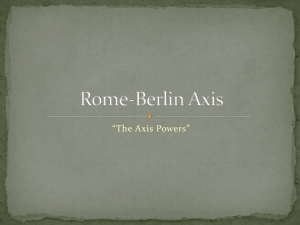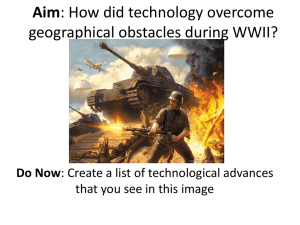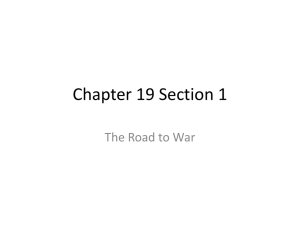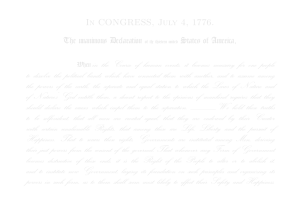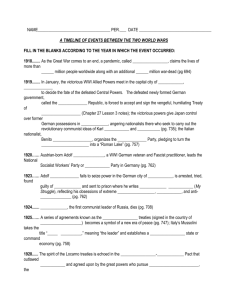DIRECT INSTRUCTION LESSON PLAN
advertisement
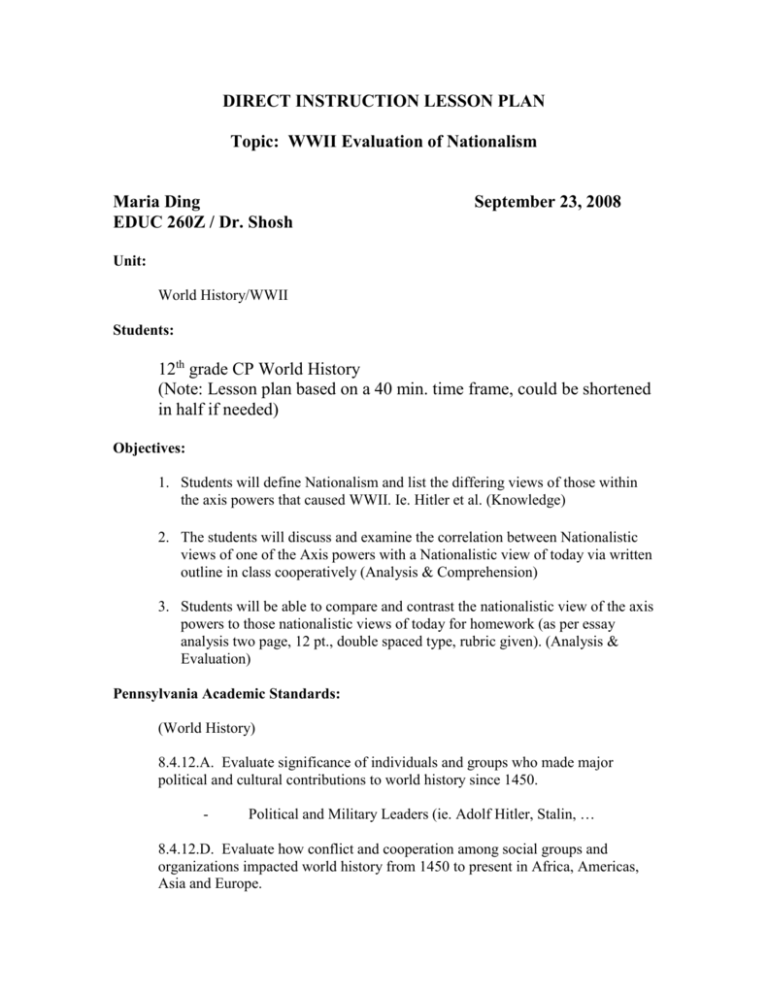
DIRECT INSTRUCTION LESSON PLAN Topic: WWII Evaluation of Nationalism Maria Ding EDUC 260Z / Dr. Shosh September 23, 2008 Unit: World History/WWII Students: 12th grade CP World History (Note: Lesson plan based on a 40 min. time frame, could be shortened in half if needed) Objectives: 1. Students will define Nationalism and list the differing views of those within the axis powers that caused WWII. Ie. Hitler et al. (Knowledge) 2. The students will discuss and examine the correlation between Nationalistic views of one of the Axis powers with a Nationalistic view of today via written outline in class cooperatively (Analysis & Comprehension) 3. Students will be able to compare and contrast the nationalistic view of the axis powers to those nationalistic views of today for homework (as per essay analysis two page, 12 pt., double spaced type, rubric given). (Analysis & Evaluation) Pennsylvania Academic Standards: (World History) 8.4.12.A. Evaluate significance of individuals and groups who made major political and cultural contributions to world history since 1450. - Political and Military Leaders (ie. Adolf Hitler, Stalin, … 8.4.12.D. Evaluate how conflict and cooperation among social groups and organizations impacted world history from 1450 to present in Africa, Americas, Asia and Europe. - Domestic Instability - Ethnic and Racial Relations - Immigration and Migration - Military Conflicts (Academic Standards for Reading, Writing, Speaking and Listening) 1.1.11.D. Identify, describe, evaluate and synthesize essential ideas in the text. 1.1.11.H. Demonstrate fluency and comprehension in reading. 1.2.11.A. Read and understand essential content of informational texts and documents in all academic areas. - Use teacher and student established criteria for making decisions and drawing conclusions. 1.2.11.B. Use and understand a variety of media and evaluate the quality of material produced. - Select appropriate electronic media for research and evaluate the quality of the information received. 1.4.11.B. Write complex informational pieces (e.g. research papers, analyses, evaluations, essays) - Include a variety of methods to develop the main idea. - Use precise language and specific detail. - Include cause and effect. - Use primary and secondary sources. 1.4.11.C. Write persuasive pieces. - Include clearly stated position or opinion. - Develop reader interest. - Include a variety of methods to advance the argument or position. Instructional Procedures: 1. As a hook, ask question: What is Nationalism? (2 min.) 2. 3. 4. 5. 6. - First, give students time to answer. - Second, show power point of definition. - Finally, have the students write definition in notebook. Ask students if they have heard of the Axis Powers. (2 min.) - Make mental note of students that are familiar with the term. - Give definition of Axis powers for students to write down. - Briefly discuss the culmination of access powers. Begin lesson by showing students power point on Hitler. (5 min.) - Have students write notes on Hitler. - Brief analysis of Hitler info and photo. Introduce next power point on Mussolini. (5 min.) - Have students write notes on Mussolini. - Brief analysis of Mussolini info and photo. Introduce next power point on Stalin. (5 min.) - Have students write notes on Stalin. - Brief analysis of Stalin info and photo. Introduce last power point on General Yamamoto. (5 min.) - Have students write notes on Yamamoto. - Brief analysis of Yamamoto info and photo. 7. Have students group with their neighbor to discuss Axis powers, pick one and compare nationalistic views of the Axis power with a nationalistic view of someone today in chart form. As students discuss, walk around room to assist and answer questions. (15 min.) 8. Have students, for homework, write a clear two page essay comparing one of the axis powers during WWII and their Nationalistic view with a character of today and his/her Nationalistic view. (1 min.) Strategies for Diverse Learners: 1. Define Nationalism in detail and have students take notes. Give opportunity for students to ask questions if they need clarification. 2. Define what are the Axis powers. Use visual notes and pictures of the Axis powers. 3. Give detailed description of political views of Axis powers and nationalistic ideals for the students to obtain a better understanding. 4. Students work cooperatively to discuss Nationalistic views of the Axis powers with a Nationalistic view of today, compare and contrast views. 5. Give a homework regarding Nationalism and compare/contrast views of one of the Axis powers to views to Nationalistic views today essay two pages double spaced typed, 12 point. Follow rubric guidelines given at the beginning of the year. 6. Remind students that all information about Axis powers and rubric can be located on blackboard site. Evaluation Procedures: 1. Have students write notes on Nationalism and the Axis powers of WWII as well as ask questions periodically to check for understanding while discussing each of the Axis powers. (Formative) 2. Give students the opportunity for brief discussion on the topic and relation to nationalistic views in the world today with their input in a cooperative setting. Also check for relative understanding while walking around the room during discussion. (Formative and Summative) 3. Have students write a two-page essay for homework on Nationalism and have them compare/contrast views of one of the Axis powers to views to Nationalistic views today. (Summative) Materials: 1. PowerPoint presentation visual notes and pictures on Smart board. 2. Chalkboard for further clarification if needed. 3. Pass around the translated book, Mein Kampf written by Hitler. 4. Use of a map on Europe and Russia if needed. References: Adolf Hitler. (1990). Remember.org. Retrieved September 20, 2008, from http://remember.org/gyuide/Facts.root.html Benito Mussolini. (2008). GI—World War II Commemoration, Retrieved September 20, 2008, from http://www.grolier.com/wwii/wwiimussolini.html Emperor Hirohito. (1997). PBS Biography. Retrieved September 21, 2008, from http://www.pbs.org/wgbh/amex/macarthur/peopleevents/pandeAMEX97.html Fascism. (2008). In Merriam-Webster Online Dictionary. Retrieved September 20, 2008, from http://www.merriam-webster.com/dictionary/fascism Joseph Stalin. (1999). PBS Biography. Retrieved September 20, 2008, from http://www.pbs.org/redfiles/bios/all_bio_joseph_stalin.htm Militarism and WW2. (2002). Japan-guide. Retrieved September 21, 2008, from http://www.japan-guide.com/e/e2129.html Nationalism. (2005). In Stanford Encyclopedia of Philosophy. Retrieved September 20, 2008, from http://plato.stanford.edu/entries/nationalism/

